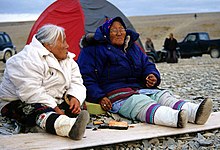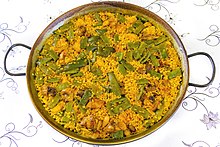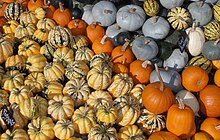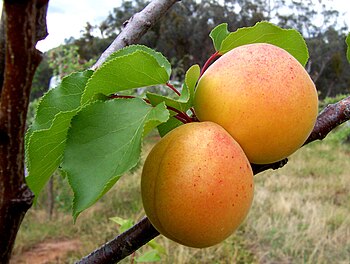Portal:Food
F o o d
A portal dedicated to food and foodways
Introduction


Food is any substance consumed by an organism for nutritional support. Food is usually of plant, animal, or fungal origin and contains essential nutrients such as carbohydrates, fats, proteins, vitamins, or minerals. The substance is ingested by an organism and assimilated by the organism's cells to provide energy, maintain life, or stimulate growth. Different species of animals have different feeding behaviours that satisfy the needs of their metabolisms and have evolved to fill a specific ecological niche within specific geographical contexts.
Omnivorous humans are highly adaptable and have adapted to obtain food in many different ecosystems. Humans generally use cooking to prepare food for consumption. The majority of the food energy required is supplied by the industrial food industry, which produces food through intensive agriculture and distributes it through complex food processing and food distribution systems. This system of conventional agriculture relies heavily on fossil fuels, which means that the food and agricultural systems are one of the major contributors to climate change, accounting for as much as 37% of total greenhouse gas emissions. (Full article...)
Cooking, also known as cookery or professionally as the culinary arts, is the art, science and craft of using heat to make food more palatable, digestible, nutritious, or safe. Cooking techniques and ingredients vary widely, from grilling food over an open fire, to using electric stoves, to baking in various types of ovens, reflecting local conditions. Cooking is an aspect of all human societies and a cultural universal.
Preparing food with heat or fire is an activity unique to humans. Archeological evidence of cooking fires from at least 300,000 years ago exists, but some estimate that humans started cooking up to 2 million years ago.
The expansion of agriculture, commerce, trade, and transportation between civilizations in different regions offered cooks many new ingredients. New inventions and technologies, such as the invention of pottery for holding and boiling of water, expanded cooking techniques. Some modern cooks apply advanced scientific techniques to food preparation to further enhance the flavor of the dish served. (Full article...)
Aeroplane Jelly is a jelly brand in Australia created in 1927 by Bert Appleroth. Appleroth's backyard business, Traders Pty Ltd, became one of Australia's largest family-operated food manufacturers and was sold to McCormick Foods Australia, a subsidiary of United States corporation McCormick & Company, in 1995. Aeroplane Jelly is the market leader in Australia's jelly market, with over 18 million packets sold annually. Strawberry is the best-selling flavour.
Aeroplane Jelly ran a successful advertising campaign featuring a jingle that has become part of Australian culture. It is one of Australia's longest-running jingles, recorded in 1937 featuring the voice of five-year-old Joy King. It was played on radio over 100 times per day in the 1940s. The jingle was added to the National Film and Sound Archive's Sounds of Australia registry in 2008. (Full article...)
Selected article –
Peanut allergy is a type of food allergy to peanuts. It is different from tree nut allergies, because peanuts are legumes and not true nuts. Physical symptoms of allergic reaction can include itchiness, hives, swelling, eczema, sneezing, asthma attack, abdominal pain, drop in blood pressure, diarrhea, and cardiac arrest. Anaphylaxis may occur. Those with a history of asthma are more likely to be severely affected.
Selected cuisine -

Historically Inuit cuisine, which is taken here to include Greenlandic cuisine, Yup'ik cuisine and Aleut cuisine, consisted of a diet of animal source foods that were fished, hunted, and gathered locally.
In the 20th century the Inuit diet began to change and by the 21st century the diet was closer to a Western diet. After hunting, they often honour the animals' spirit by singing songs and performing rituals. Although traditional or country foods still play an important role in the identity of Inuit, much food is purchased from the store, which has led to health problems and food insecurity. According to Edmund Searles in his article Food and the Making of Modern Inuit Identities, they consume this type of diet because a mostly meat diet is "effective in keeping the body warm, making the body strong, keeping the body fit, and even making that body healthy". (Full article...)Selected ingredient –

Stock, sometimes called bone broth, is a savory cooking liquid that forms the basis of many dishes – particularly soups, stews, and sauces. Making stock involves simmering animal bones, meat, seafood, or vegetables in water or wine, often for an extended period. Mirepoix or other aromatics may be added for more flavor. (Full article...)
Selected recipe –
Paella (/paɪˈɛlə/, /pɑːˈeɪjə/, py-EL-ə, pah-AY-yə, Valencian: [paˈeʎa]; Spanish: [paˈeʝa]) is a rice dish originally from the Valencian Community. Paella is regarded as one of the community's identifying symbols. It is one of the best-known dishes in Spanish cuisine.
The dish takes its name from the wide, shallow traditional pan used to cook the dish on an open fire, paella being the word for a frying pan in Valencian language. As a dish, it may have ancient roots, but in its modern form, it is traced back to the mid-19th century, in the rural area around the Albufera lagoon adjacent to the city of Valencia, on the Mediterranean coast of Spain. (Full article...)
Cucurbita (Latin for 'gourd') is a genus of herbaceous fruits in the gourd family, Cucurbitaceae (also known as cucurbits or cucurbi), native to the Andes and Mesoamerica. Five edible species are grown and consumed for their flesh and seeds. They are variously known as squash, pumpkin, or gourd, depending on species, variety, and local parlance. Other kinds of gourd, also called bottle-gourds, are native to Africa and belong to the genus Lagenaria, which is in the same family and subfamily as Cucurbita, but in a different tribe. These other gourds are used as utensils or vessels, and their young fruits are eaten much like those of the Cucurbita species.
Most Cucurbita species are herbaceous vines that grow several meters in length and have tendrils, but non-vining "bush" cultivars of C. pepo and C. maxima have also been developed. The yellow or orange flowers on a Cucurbita plant are of two types: female and male. The female flowers produce the fruit and the male flowers produce pollen. Many North and Central American species are visited by specialist bee pollinators, but other insects with more general feeding habits, such as honey bees, also visit. (Full article...)Selected image –
Selected biography –
B. September 13, 1857 – d. October 13, 1945
Milton Snavely Hershey (September 13, 1857 – October 13, 1945) was an American chocolatier, businessman, and philanthropist.
Trained in the confectionery business, Hershey pioneered the manufacture of caramel, using fresh milk. He launched the Lancaster Caramel Company, which achieved bulk exports, and then sold it to start a new company supplying mass-produced milk chocolate, previously a luxury good. (Full article...)
Did you know (auto-generated) –

- ... that food stylist Susan Spungen estimated that she baked hundreds of pies with Josh Brolin and film staff while practicing for a scene in Labor Day?
- ... that New Zealand editor and journalist Madeleine Chapman, known for fashion label exposés and snack food ranking lists, is a champion javelin thrower?
- ... that Turkish migrant workers living in a residential complex in Amsterdam refused to eat the Dutch food for two weeks after the kitchen's only Turkish chef was fired?
- ... that Kenneth Lo was called "the foremost expert in Britain on Chinese food"?
- ... that fermented leaves are used to make a meat substitute in Sudan called kawal?
- ... that food YouTuber Mike Chen also runs a channel documenting strange phenomena?
More did you know –
Related portals
Food topics
The following are topics relating to food
Categories
Food list articles
- See also: Lists of foods and Category:Lists of drinks
The following are some Food list articles on Wikipedia:

- American cheeses
- Appellation d'Origine Contrôlée cheeses
- Apple cultivars
- Bacon dishes
- Bacon substitutes
- Basil cultivars
- Breads
- Breakfast beverages
- Breakfast cereals
- Breakfast foods
- British cheeses
- Cakes
- Candies
- Cheeses
- Cheese soups
- Christmas dishes (list)
- Cocktails
- Cookies
- Dishes using coconut milk
- Diets
- Doughnut varieties
- Egg dishes
- Fermented soy products
- Food additives
- Food additives (Codex Alimentarius)
- Foods named after people
- French cheeses
- French dishes
- Fried dough foods
- Fruits
- List of hamburgers
- Herbs and spices
- Hors d'oeuvre
- Indian dishes
- Indian snack foods
- Indonesian dishes
- Italian dishes
- Japanese snacks
- Japanese dishes
- Jewish dishes
- Kebabs
- Korean beverages
- Mango cultivars
- Moroccan dishes
- Pasta
- Pastries
- Philippine snack food
- Pies, tarts and flans
- Poppy seed pastries and dishes
- Potato dishes
- Puddings
- Raw fish dishes
- Rice dishes
- Rolled foods
- Sauces
- Seafood
- Seeds
- Sandwiches
- Snack foods
- Soft drinks by country
- Soul foods and dishes
- Soups
- Stews
- Street foods
- Tapas
- Turkish dishes
- Twice-baked foods
- Vegetable oils
- Vegetables
- Vodkas
Things you can do
Related WikiProjects
| Parent project: WikiProject Food and Drink | |
| Child projects: | Task forces: (All inactive) |
|
|
| Related projects: | |
New articles
Rules | Match log | Results page (for watching) | Last updated: 2024-05-31 19:27 (UTC)
Note: The list display can now be customized by each user. See List display personalization for details.
- Brennans Bread (edit | talk | history | links | watch | logs | tools) by Gatepainter (talk · contribs · new pages (3)) started on 2024-05-31, score: 20
- Karin-Lis Svarre (edit | talk | history | links | watch | logs | tools) by Ipigott (talk · contribs · new pages (13)) started on 2024-05-31, score: 10
- Indori poha (edit | talk | history | links | watch | logs | tools) by Apocheir (talk · contribs · new pages (5)) started on 2024-05-30, score: 20
- Tanuki (restaurant) (edit | talk | history | links | watch | logs | tools) by Another Believer (talk · contribs · new pages (111)) started on 2024-05-30, score: 10
- Lena Ice Cream (edit | talk | history | links | watch | logs | tools) by Syazwi Irfan (talk · contribs · new pages (4)) started on 2024-05-23, score: 30
- Ko Myeong-seok (edit | talk | history | links | watch | logs | tools) by Explicit (talk · contribs · new pages (4)) started on 2024-05-30, score: 10
- Savanyúság (edit | talk | history | links | watch | logs | tools) by Konnor Martin (talk · contribs · new pages (1)) started on 2024-05-29, score: 10
- Laal maas (edit | talk | history | links | watch | logs | tools) by SafariScribe (talk · contribs · new pages (157)) started on 2024-05-29, score: 30
- Furrundu (edit | talk | history | links | watch | logs | tools) by BaduFerreira (talk · contribs · new pages (3)) started on 2024-05-29, score: 50
- Hyman's Seafood (edit | talk | history | links | watch | logs | tools) by DMVHistorian (talk · contribs · new pages (6)) started on 2024-05-28, score: 10
- Pickup Coffee (edit | talk | history | links | watch | logs | tools) by Hariboneagle927 (talk · contribs · new pages (20)) started on 2024-05-28, score: 20
- Geoffrey Hawtin (edit | talk | history | links | watch | logs | tools) by Chromista (talk · contribs · new pages (1)) started on 2024-05-28, score: 10
- Palani Panchamirtham (edit | talk | history | links | watch | logs | tools) by Magentic Manifestations (talk · contribs · new pages (13)) started on 2024-05-27, score: 10
- Erismatopterus (edit | talk | history | links | watch | logs | tools) by Kevmin (talk · contribs · new pages (20)) started on 2024-05-27, score: 10
- Saskatoon berry pie (edit | talk | history | links | watch | logs | tools) by Reywas92 (talk · contribs · new pages (2)) started on 2024-05-27, score: 30
- Zus Coffee (edit | talk | history | links | watch | logs | tools) by Hariboneagle927 (talk · contribs · new pages (20)) started on 2024-05-27, score: 20
- Space Cola Wars (edit | talk | history | links | watch | logs | tools) by Artem.G (talk · contribs · new pages (13)) started on 2024-05-27, score: 10
- Conchas de Piedra (edit | talk | history | links | watch | logs | tools) by Another Believer (talk · contribs · new pages (111)) started on 2024-05-27, score: 10
- Torta Balcarce (edit | talk | history | links | watch | logs | tools) by Murmuring Rock (talk · contribs · new pages (4)) started on 2024-05-25, score: 20
- Bilal Yalcinkaya (edit | talk | history | links | watch | logs | tools) by Das osmnezz (talk · contribs · new pages (55)) started on 2024-05-23, score: 10
- Andok's (edit | talk | history | links | watch | logs | tools) by Karich28 (talk · contribs · new pages (4)) started on 2024-05-22, score: 20
- Doe Donuts (edit | talk | history | links | watch | logs | tools) by Another Believer (talk · contribs · new pages (111)) started on 2024-05-23, score: 10
- I, the Executioner (2024 film) (edit | talk | history | links | watch | logs | tools) by Οἶδα (talk · contribs · new pages (55)) started on 2024-05-21, score: 10
- Virginia Sole-Smith (edit | talk | history | links | watch | logs | tools) by Marquardtika (talk · contribs · new pages (1)) started on 2024-05-22, score: 10
- Lohusa şerbeti (edit | talk | history | links | watch | logs | tools) by Macrakis (talk · contribs · new pages (8)) started on 2024-05-22, score: 30
- I, the Executioner (edit | talk | history | links | watch | logs | tools) by Οἶδα (talk · contribs · new pages (55)) started on 2024-05-21, score: 10
- Paul Parkman (edit | talk | history | links | watch | logs | tools) by Thriley (talk · contribs · new pages (67)) started on 2024-05-21, score: 10
- Two Roosters Ice Cream (edit | talk | history | links | watch | logs | tools) by Johnson524 (talk · contribs · new pages (4)) started on 2024-05-21, score: 10
- There Be Monsters (edit | talk | history | links | watch | logs | tools) by Another Believer (talk · contribs · new pages (111)) started on 2024-05-21, score: 10
- Chinir saaj (edit | talk | history | links | watch | logs | tools) by Moriwen (talk · contribs · new pages (264)) started on 2024-05-21, score: 30
- Doogh (edit | talk | history | links | watch | logs | tools) by MuhammedBenShalom (talk · contribs · new pages (1)) started on 2024-05-21, score: 20
- Sata physic gardens (edit | talk | history | links | watch | logs | tools) by MChew (talk · contribs · new pages (17)) started on 2024-05-21, score: 10
- Nam Dae-sik (edit | talk | history | links | watch | logs | tools) by Das osmnezz (talk · contribs · new pages (55)) started on 2024-05-20, score: 10
- Le Chique (edit | talk | history | links | watch | logs | tools) by Another Believer (talk · contribs · new pages (111)) started on 2024-05-20, score: 10
- Khanom met khanun (edit | talk | history | links | watch | logs | tools) by Quantplinus (talk · contribs · new pages (1)) started on 2024-05-18, score: 10
- Pao Alentejano (edit | talk | history | links | watch | logs | tools) by Valereee (talk · contribs · new pages (9)) started on 2024-05-20, score: 10
- Sir Grapefellow and Baron von Redberry (edit | talk | history | links | watch | logs | tools) by Retrosunshine2006 (talk · contribs · new pages (1)) started on 2024-05-20, score: 20
- Pharasmanes II (edit | talk | history | links | watch | logs | tools) by BilledMammal (talk · contribs · new pages (199)) started on 2024-05-19, score: 10
- Kinamatisang manok (edit | talk | history | links | watch | logs | tools) by Obsidian Soul (talk · contribs · new pages (7)) started on 2024-05-19, score: 10
- Federal Food, Drug, and Cosmetic Act of 1938 (edit | talk | history | links | watch | logs | tools) by Irruptive Creditor (talk · contribs · new pages (2)) started on 2024-05-19, score: 10
- IT'SUGAR (edit | talk | history | links | watch | logs | tools) by AbsentPat (talk · contribs · new pages (3)) started on 2024-05-19, score: 20
- Harvey's Butter Rum Batter (edit | talk | history | links | watch | logs | tools) by AbsentPat (talk · contribs · new pages (3)) started on 2024-05-19, score: 20
- Mar-Jac Poultry (edit | talk | history | links | watch | logs | tools) by TJMSmith (talk · contribs · new pages (13)) started on 2024-05-18, score: 10
- Festival del Sole (edit | talk | history | links | watch | logs | tools) by 87.74.175.29 (talk · contribs · new pages (2)) started on 2024-05-18, score: 20
- Joyride Sweets (edit | talk | history | links | watch | logs | tools) by Bennett1203 (talk · contribs · new pages (23)) started on 2024-05-18, score: 40
- Khanom Med Khanoon (edit | talk | history | links | watch | logs | tools) by Quantplinus (talk · contribs · new pages (1)) started on 2024-05-18, score: 10
- Tony Connor (musician) (edit | talk | history | links | watch | logs | tools) by Anavatar (talk · contribs · new pages (8)) started on 2024-05-18, score: 10
- Patrick Olive (edit | talk | history | links | watch | logs | tools) by Anavatar (talk · contribs · new pages (8)) started on 2024-05-18, score: 10
- Taquería El Califa de León (edit | talk | history | links | watch | logs | tools) by Tbhotch (talk · contribs · new pages (28)) started on 2024-05-18, score: 10
- Harvey Hinsley (edit | talk | history | links | watch | logs | tools) by Anavatar (talk · contribs · new pages (8)) started on 2024-05-17, score: 10
- Fulcrum Coffee (edit | talk | history | links | watch | logs | tools) by Another Believer (talk · contribs · new pages (111)) started on 2024-05-17, score: 10
Associated Wikimedia
The following Wikimedia Foundation sister projects provide more on this subject:
-
Commons
Free media repository -
Wikibooks
Free textbooks and manuals -
Wikidata
Free knowledge base -
Wikinews
Free-content news -
Wikiquote
Collection of quotations -
Wikisource
Free-content library -
Wikiversity
Free learning tools -
Wiktionary
Dictionary and thesaurus
















































